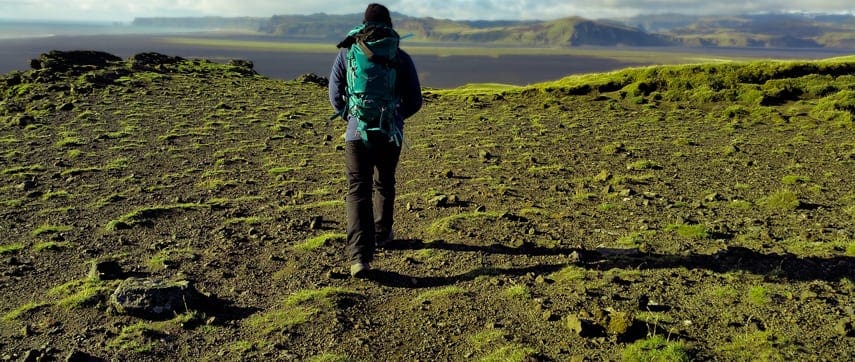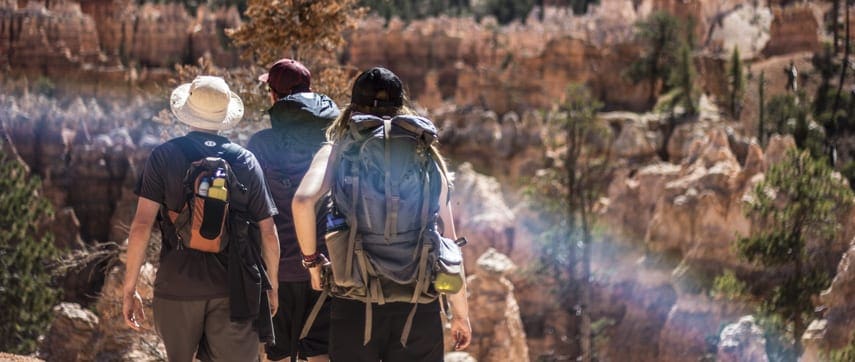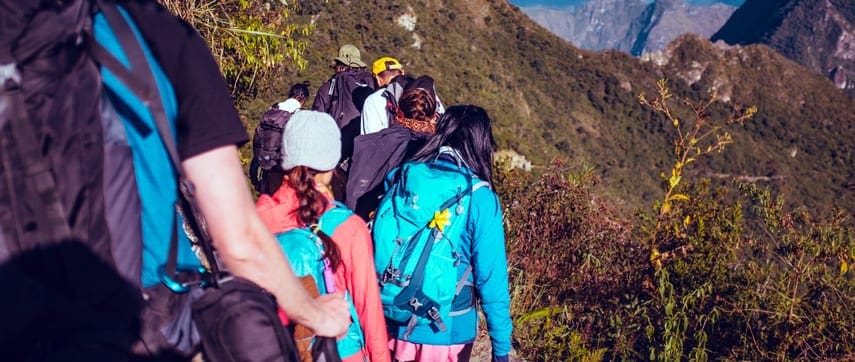Leading a hike is not always as simple as strapping on your pack and expecting the rest of the group to follow. There are different levels of fitness, capabilities, experience, skills, personalities and pace of individuals to consider when keeping your hiking group together.
When heading out on a hike you will generally fall into one of the following categories;
- Hiking solo
- Hiking with friends
- Hiking with a group (some might be friends but there will often be hikers who are new to your group or new to hiking).
A regular problem that can occur in larger hiking groups is that the group can easily spread out as the hike progresses. Some of your party will get chatting, some will stop to take photos, some are faster over rocky terrain or rock scrambles, some are simply fitter than others and can maintain a faster pace. Inevitably, a gap between the lead and whip of your group opens up and the main role of the group leader is to make sure that the gap doesn’t get so wide as to become unmanageable to the point where one part of the group can’t locate the other.
Whether you hike with hiking friends or with a large group this is a potential challenge that you need to prepare for.
Hiking Solo
It is not recommended, by various authorities, that you hike alone for obvious reasons such as safety and survival. However, deciding to hike solo or not is completely your decision to make and a decision you should not take lightly. I won’t cover all of the recommendations for solo hiking here as this article is about keeping your hiking group together. What I will say is that you need to plan, plan, plan and be realistic about your skills, pain threshold, endurance, and what you enjoy. If group hiking is more fun, stick with that.
Hiking with Friends
Hiking with friends can be a very rewarding experience. You get to share something you enjoy with your friends and will often form strong bonds due to your shared love of the outdoors and the time you spend together in it.
When hiking with friends it is likely that you all share a similar skill set, fitness and endurance as these are often the things that created the initial attraction between you. Hikes are more enjoyable when everyone travels together and appreciate the same style and difficulty of hike and that enjoyment is generally the seed that the development of your friendship. Even if you don’t all share a similar pace or endurance you will know each other’s skill set well enough to understand when you need to offer assistance, when you need to wait and when you need to slow down in order to keep together as a group.
There will always be members of your group who have a few extra gears when it comes to ascending or descending hills or are more confident over uneven terrain and rock scrambles. This is generally not an issue when hiking with friends who hike regularly as you will be aware of the groups strengths and weaknesses and will accommodate every member of your group accordingly.
When I head out with friends we are generally in a group of anywhere from two to ten. Someone always takes the lead for a particular hike, generally based on who thought of the hike and who did most of the planning. It isn’t always that formal though and if someone has a route idea, we all head out and assist with the navigation and leading. We all have appropriate gear and are all reasonably good at navigation so if the group spreads out because some members want to push themselves a little harder or someone wants to stop and take photos or drop back for a chat, that’s not an issue as we all follow a few simple rules. Stop if someone needs the toilet and wait at every trail junction or at the end of every ascent or descent. It is these rules and understanding of them that keeps our group together and something I believe everyone should practice when hiking with friends.
Hiking with a Group
When you are hiking in a group it is a much more formal affair. There should always be a nominated leader and a whip (skilled hiker at the back to help keep the group together). This should always be the case as there will be members of your group with varied abilities, experience and levels of fitness. A lot more planning and pre-hike checking needs to be undertaken if this is to be a successful hike. Unfortunately, it is not uncommon for people to sign up for hikes that are not within their level of fitness and experience. People will turn up with the inappropriate gear for a particular type of hike and will not be carrying adequate water for the temperature, distance and difficulty of the hike.
All of these type of things could of course lead to issues on the trail so a lot more diligence and policing is required by the group leader. Group hikes may also have greater numbers which can be anything up to 16 people; the recommended maximum number for environmental, safety and group management reasons. There should always be at least one leader who is responsible for navigating the route and setting the pace and usually a whip, depending on group size, to shepherd everyone from the back of the group and ensure that no-one strays and avoid large gaps from developing. This role of the whip becomes even more important as the weather changes as in bad weather they will need to ensure that the group keeps tighter together.
As a leader it is important that when promoting your hike to the group you correctly describe the hike, the grade, expected time to complete as well as any requirements such as hiking poles, wet weather gear, volume of water to carry etc. This will assist in managing people’s expectations and will hopefully encourage them to only sign up to hikes they are suited to.
It is a good idea to insist that newbies start on a few lower grade hikes so the group leaders can get a feel for the person’s abilities and fitness before allowing them to sign up for longer, more challenging hikes. The person can then confidently sign up to a higher level hike if they are really fit as that will be evident on their first time out. Many hikers are involved in a number of hiking groups and it is important to note that not all groups grade or manage their hikes the same. What will be graded as 3 (moderate) in one group might just be a 2 (easy) or 4 (difficult) in another group. The reason for this is that not all hikers follow the approved grading system and base the level of difficulty on their own personal abilities, not that of the group.
While grading hikes is my recommended practise, it still doesn’t prevent the group from spreading out on the trail. When your group is larger and filled with hikers you don’t know it can be very easy for one or more large gaps to form, as mentioned earlier.
How to avoid groups spreading out
On most group hikes the faster paced hikers will break out in front and set their own pace. Quite often they will even pass the leader of the group and create a large gap between them and the following sub-group. As a leader it often just seems easier to just let people go at their own pace as you want everyone to enjoy the experience. What this does though is makes the slower hikers feel inadequate and leaves them feeling annoyed and frustrated with themselves and the group. If they lose sight of the group, they may even start to panic as their navigation skills and confidence in the bush might not be great. It will also leave you feeling frustrated with them that they aren’t keeping up the pace and you may even start wishing they had never joined your hike.
The solution is to plan your hike for the slowest person. One that is suitable for everyone in your party and let the slower person set the pace. You can still lead the hike directly behind them and offer words of encouragement and assist them in learning how to navigate the trail. You might not know how slow they will be during the pre-hike planning so ask questions as they sign up to the hike. If you don’t find out until you are on the trail, then be accommodating enough to adjust your plans, pace and route (if need be) accordingly. There is nothing more frustrating and potentially dangerous than a slow hiker falling behind the group.
The benefit of the slowest person leading is that all other people in the group, even if they are busy chatting or taking photos, will be more than able to keep pace and the group will remain together. There is of course a downside when you employ this tactic as you may stop the group from splitting up, but will quite likely aggravate a large portion of the group who would prefer to be hiking faster. If they are constantly having to reel in their pace to stay in line with slower members at the front, they may not be happy and quite possibly not enjoy the hike. I always struggled with this as a group leader as I wanted to please everyone. The reality is that when you lead a hike not knowing everyone’s capabilities you have to focus on group management and safety as your primary concern. If the group stays together that is a lot more important than keeping everyone happy. The slowest person will appreciate you considering them and as they hike more their fitness and pace will also improve.
Using the tactic of the slowest person at the front does present a trade-off. Ideally the grading and description of your hikes eliminates this problem but the reality is that it won’t. When you place the slower members of your group at the front you should not allow them to dawdle. Continually encourage them to walk at a pace that is challenging enough for them but comfortable for everyone else. Show them that you are being mindful of their ability in the hope they will be respectful of that of others.
If faster members insist on pushing forward out of frustration and gaps do form, then pull your group together regularly so that you are having short rests often rather than making the faster paced hikers wait for ages for the slower members to catch up (this is particularly important in cold weather). If you do need to keep a large group much tighter due to a challenging route or poor visibility, putting the slowest people up front alongside the leader and issuing a strict instruction to everyone else to stay behind and in touch with the lead group, should go a long way to making your role a little easier.
A few final tips on keeping a group together
- Before I commence any hike, even with friends, I always tell people to keep sight of the person in front of them. If they lose sight of the group, then call out so that the group can slow or stop to allow them to catch up. This is particularly important in bad weather or dense bush where only a few metres can make all the difference.
- If anyone needs to stop to go to the toilet, make sure you tell someone before you stop and always leave you pack on the trail at the point where you left. This will allow your group to stop a little down the trail to wait and to easily locate you if required.
- Conduct a head count at the start of the hike and at regular intervals along the trail. I generally do this at every trail junction so if someone is unaccounted for you have a better idea of how far back they will be.
- Instruct all members that if they do fall behind and lose sight of the group that they should continue in the direction of travel until they reach the next trail junction then wait for the group or the group leader to return.
As a leader you need to be able to concentrate on navigation and the last thing you need is to have to locate a lost or wayward hiker who has fallen behind the group. My advice is to keep everyone together and keep everyone safe.
Author: Darren Edwards – Trail Hiking Australia















Also, some leaders do not adequately consider the problem that when the slowest walkers reach the main group, they will need a longer rest than the fitter members, who may already feel sufficiently rested by the time the least fit members and tail-end charlie catch-up ! More reason to keep the slowest at the head of the group ….
Great comment. I have that under the tips section of the site too. https://www.trailhiking.com.au/plan-your-hike-for-the-slowest-person/
Simone Preston ?
Christine thank you for sharing ? will have a read a bit later.